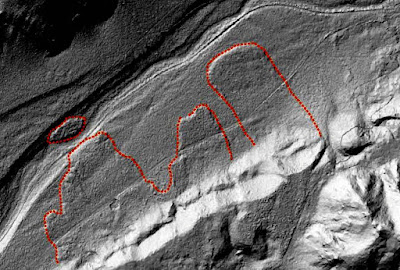A look at the Wenatchee geology map shows that a fair bit of Wenatchee is underlain by alluvial fan deposits. I have not done any specific alluvial fan work in Wenatchee, but there is a history of flash floods coming out of the very steep drainages in Chelan County with terrible consequences (Flash flood in South Wenatchee kills 16 people on September 5, 1925). Pictures archived at the Washington State Historical Society show some of the devastation from Squilchuck Creek.
Squilchuck Creek has a larger drainage area than some of the other streams that enter Wenatchee from the steep mountain front to the west and is incised into the alluvial fan surface such that flash floods are delivered further down stream. Number one Canyon and Number Two Canyon end on alluvial fans with residential development.
The sediment collection system was tested this past winter by heavy rapid snow melt and very wet weather. There was some mud and water flows reported, but the collection swale reduced the sediment load fro the event.
The depth of projected flooding on the maps is not very high. However, the velocities are not safe for walking through and it should be assumed that there will be a lot of sediment and potentially debris involved in any flash flood event. The big risk is from stationary thunderstorms that would cause a very rapid flash flood with debris. A greater awareness of that risk developed over the past few years because of flash floods elsewhere on the east slopes of the Cascades.
I am not up on just what the projected recurrence interval would be or the consequences specific to Number 1 and Number 2 Canyons. The recent work on Canyon Number 1 (Number 1 Canyon Project) and some at Canyon Number 2 indicates that Chelan County and Wenatchee are aware of the risk. The County has a relatively new county-wide flood district and a few reports note that there has been an increase in intense summer storms and associated flash flooding in both Chelan and Douglas Counties.
Topography with well over 2,000 feet of vertical relief (USGS)
Aerial view of of drainages (USGS)
Lower end of Number 1 Canyon with hard to discern stream channel (image USGS)
Upper alluvial fan area on Number 1 Canyon (image USGS)
Sediment collection swale recently completed (Google earth)
The sediment collection system was tested this past winter by heavy rapid snow melt and very wet weather. There was some mud and water flows reported, but the collection swale reduced the sediment load fro the event.
FEMA flood maps show the projected flood elevations and velocities for the lower canyons and upper alluvial fans.
The depth of projected flooding on the maps is not very high. However, the velocities are not safe for walking through and it should be assumed that there will be a lot of sediment and potentially debris involved in any flash flood event. The big risk is from stationary thunderstorms that would cause a very rapid flash flood with debris. A greater awareness of that risk developed over the past few years because of flash floods elsewhere on the east slopes of the Cascades.
I am not up on just what the projected recurrence interval would be or the consequences specific to Number 1 and Number 2 Canyons. The recent work on Canyon Number 1 (Number 1 Canyon Project) and some at Canyon Number 2 indicates that Chelan County and Wenatchee are aware of the risk. The County has a relatively new county-wide flood district and a few reports note that there has been an increase in intense summer storms and associated flash flooding in both Chelan and Douglas Counties.









































